New Products & Services
December 2022
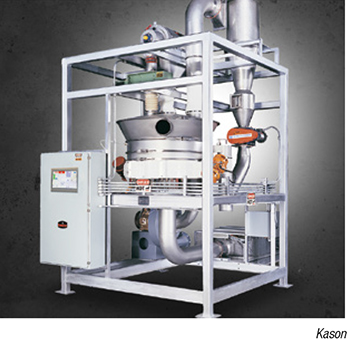 This company has upgraded its Vibro-Bed fluid-bed processor (photo) with new features designed to regulate pressure and temperature more efficiently for faster material drying and increased throughput. Fluid-bed processors dry, moisturize, heat or cool bulk material by causing it to vibrate on a screen or perforated surface within a rising column of heated, chilled or moisturized air. In addition to faster drying, the Vibro-Bed’s upgraded controls make it easier for operators with minimal training to run batch or continuous material processing. An energy-efficient circular design utilizes 100% of the surface area to optimize airflow for faster drying, less waste and a more consistent product, according to the company. The Vibro-Bed product range includes eight compact models ranging from 24 to 84 in. (610 to 2125 mm) in diameter. Configurations are avilable for scalping, de-dusting, agglomerating or de-agglomerating materials while they are dried, cooled or moisturized to save on the cost of operating separate equipment. — Kason Corp., Millburn, N.J.
This company has upgraded its Vibro-Bed fluid-bed processor (photo) with new features designed to regulate pressure and temperature more efficiently for faster material drying and increased throughput. Fluid-bed processors dry, moisturize, heat or cool bulk material by causing it to vibrate on a screen or perforated surface within a rising column of heated, chilled or moisturized air. In addition to faster drying, the Vibro-Bed’s upgraded controls make it easier for operators with minimal training to run batch or continuous material processing. An energy-efficient circular design utilizes 100% of the surface area to optimize airflow for faster drying, less waste and a more consistent product, according to the company. The Vibro-Bed product range includes eight compact models ranging from 24 to 84 in. (610 to 2125 mm) in diameter. Configurations are avilable for scalping, de-dusting, agglomerating or de-agglomerating materials while they are dried, cooled or moisturized to save on the cost of operating separate equipment. — Kason Corp., Millburn, N.J.
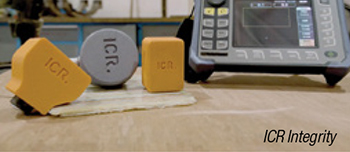 Insono is a new non-destructive testing (NDT) technique for the inspection of composite repairs applied to metallic components. Insono complements this company’s Technowrap range, and provides operators with assurance required by the regulatory bodies. It also allows for the extension of defined-life repairs, reducing waste while avoiding carbon emissions from traditional steel-replacement alternatives. Validated by The Welding Institute (TWI) with patent and U.K. accreditation pending, the portable hand-held equipment and specifically designed probes (photo) allow for inspection of all geometries, including complex configurations, and can easily be deployed in the field in hard-to-reach locations. — ICR Integrity. Aberdeen, U.K.
Insono is a new non-destructive testing (NDT) technique for the inspection of composite repairs applied to metallic components. Insono complements this company’s Technowrap range, and provides operators with assurance required by the regulatory bodies. It also allows for the extension of defined-life repairs, reducing waste while avoiding carbon emissions from traditional steel-replacement alternatives. Validated by The Welding Institute (TWI) with patent and U.K. accreditation pending, the portable hand-held equipment and specifically designed probes (photo) allow for inspection of all geometries, including complex configurations, and can easily be deployed in the field in hard-to-reach locations. — ICR Integrity. Aberdeen, U.K.
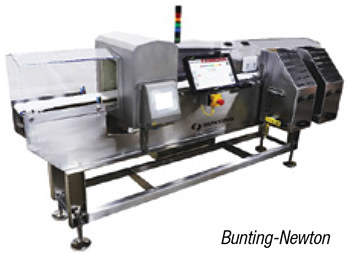 This company has developed a new unit that combines metal detection and weighing to streamline product packaging applications, leading to improved reliability, throughput rates and accuracy. The Metal Detector Checkweigher Combo (photo), unveiled at Pack Expo in Chicago, employs a high-performance weigh cell that uses electromagnetic force restorations (EMFR) technology, instead of the traditional strain gages used in other scales. Moving along a conveyor, the package is first inspected for metal. If traces of metal are detected, the package is automatically rejected without slowing down the line. As pure packages continue along the conveyor, they are then checked for accurate weight. If it is either over or under the prescribed weight, then it is rejected into a different bin. — Bunting-Newton, Newton, Kan.
This company has developed a new unit that combines metal detection and weighing to streamline product packaging applications, leading to improved reliability, throughput rates and accuracy. The Metal Detector Checkweigher Combo (photo), unveiled at Pack Expo in Chicago, employs a high-performance weigh cell that uses electromagnetic force restorations (EMFR) technology, instead of the traditional strain gages used in other scales. Moving along a conveyor, the package is first inspected for metal. If traces of metal are detected, the package is automatically rejected without slowing down the line. As pure packages continue along the conveyor, they are then checked for accurate weight. If it is either over or under the prescribed weight, then it is rejected into a different bin. — Bunting-Newton, Newton, Kan.
![]() This company has introduced a new manual dumping system with integral conveyor and separate dust collector (photo), which is suitable for dairy powders, pharmaceutical products and contamination-sensitive bulk foods. Designed and finished to 3-A sanitary standards, the system is composed of a manual dumping station with a surge hopper, a flexible screw conveyor and a support boom on a caster-mounted frame, plus a separate, mobile dust-collection system that can be configured alongside or remotely. The mobile system can serve multiple functions throughout the plant, and then be rolled to a washdown station and storage area. A dust hood is mounted to the floor hopper with quick-release clamps, and is equipped with an internal baffle and air-vent port for efficient dust collection. A support tray allows operators to stage manual additions from handheld sacks before dumping material through a grate fabricated of powerful rare-earth neodynium-iron-boron magnet material. The hopper is equipped with a mechanical agitator assembly to promote uninterrupted flow into the charging adapter of a 10-ft flexible screw conveyor with a stainless-steel screw engineered to handle the conveyed product. Fully enclosed in a polymer tube inclined at 45 deg, the flexible screw is the only moving part contacting material, and is driven by an electric motor beyond the point of discharge, preventing material contact with the motor shaft seal. — Flexicon Corp., Bethlehem, Pa.
This company has introduced a new manual dumping system with integral conveyor and separate dust collector (photo), which is suitable for dairy powders, pharmaceutical products and contamination-sensitive bulk foods. Designed and finished to 3-A sanitary standards, the system is composed of a manual dumping station with a surge hopper, a flexible screw conveyor and a support boom on a caster-mounted frame, plus a separate, mobile dust-collection system that can be configured alongside or remotely. The mobile system can serve multiple functions throughout the plant, and then be rolled to a washdown station and storage area. A dust hood is mounted to the floor hopper with quick-release clamps, and is equipped with an internal baffle and air-vent port for efficient dust collection. A support tray allows operators to stage manual additions from handheld sacks before dumping material through a grate fabricated of powerful rare-earth neodynium-iron-boron magnet material. The hopper is equipped with a mechanical agitator assembly to promote uninterrupted flow into the charging adapter of a 10-ft flexible screw conveyor with a stainless-steel screw engineered to handle the conveyed product. Fully enclosed in a polymer tube inclined at 45 deg, the flexible screw is the only moving part contacting material, and is driven by an electric motor beyond the point of discharge, preventing material contact with the motor shaft seal. — Flexicon Corp., Bethlehem, Pa.
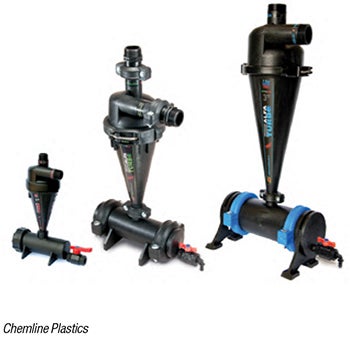 HN Series Hydro Cyclones (photo) are designed to separate sand and other solids from water using centrifugal force. HN Series Hydro Cyclones are suitable for use in pre-filtration applications in membrane water-treatment systems. The HN Series is offered in three sizes. The 1-in. cone is made of glass filled polyamide (PAG), while the 2- and 3-in. cones are made of glass filled polypropylene (PPG). Plastic construction means that these units are lightweight and resistant to corrosion and abrasion. Water enters the filter tangentially to the cone body and is accelerated by circular motion. The sand or other solids are pushed against the cone side walls and by centrifugal force and settle into a bleed tank while clear water flows up through the central outlet. The tank may be flushed occasionally using the supplied ball valve. — Chemline Plastics Ltd., Thornhill, Ont., Canada
HN Series Hydro Cyclones (photo) are designed to separate sand and other solids from water using centrifugal force. HN Series Hydro Cyclones are suitable for use in pre-filtration applications in membrane water-treatment systems. The HN Series is offered in three sizes. The 1-in. cone is made of glass filled polyamide (PAG), while the 2- and 3-in. cones are made of glass filled polypropylene (PPG). Plastic construction means that these units are lightweight and resistant to corrosion and abrasion. Water enters the filter tangentially to the cone body and is accelerated by circular motion. The sand or other solids are pushed against the cone side walls and by centrifugal force and settle into a bleed tank while clear water flows up through the central outlet. The tank may be flushed occasionally using the supplied ball valve. — Chemline Plastics Ltd., Thornhill, Ont., Canada
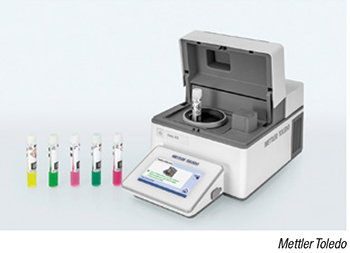 Easy Vis (photo) is a new instrument that analyzes liquid, translucent samples for their optical spectrum, color and water parameters. Combining these critical measuring tasks into one device, Easy Vis takes over the measuring tasks of up to three instruments: a colorimeter, a spectrophotometer and special measuring devices for water testing, such as titration. Analysis results appear onscreen within seconds. Easy VIS is suitable for use in quality-control laboratories at small manufacturers in the food-and-beverage industry, environmental testing labs or any industry needing quality control for products or process water or wastewater streams. The Easy VIS is used during multiple steps of the production process: for inspection of raw materials; for quality control of semi-finished and finished products; or for testing the water quality of wastewater. These capabilities are especially valuable for laboratories that previously sent out samples to an external laboratory, because they can now conduct in-house analyses. Easy VIS operates within a wavelength range of 330 to 1,000 nm. The light source is an easy-to-replace tungsten lamp. — Mettler-Toldeo GmbH, Nänikon, Switzerland
Easy Vis (photo) is a new instrument that analyzes liquid, translucent samples for their optical spectrum, color and water parameters. Combining these critical measuring tasks into one device, Easy Vis takes over the measuring tasks of up to three instruments: a colorimeter, a spectrophotometer and special measuring devices for water testing, such as titration. Analysis results appear onscreen within seconds. Easy VIS is suitable for use in quality-control laboratories at small manufacturers in the food-and-beverage industry, environmental testing labs or any industry needing quality control for products or process water or wastewater streams. The Easy VIS is used during multiple steps of the production process: for inspection of raw materials; for quality control of semi-finished and finished products; or for testing the water quality of wastewater. These capabilities are especially valuable for laboratories that previously sent out samples to an external laboratory, because they can now conduct in-house analyses. Easy VIS operates within a wavelength range of 330 to 1,000 nm. The light source is an easy-to-replace tungsten lamp. — Mettler-Toldeo GmbH, Nänikon, Switzerland
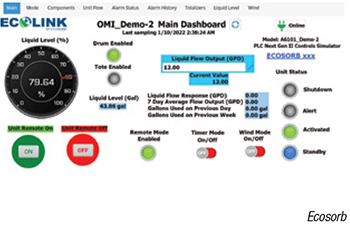 Ecolink (photo) is an online portal for remote monitoring and control of this company’s industrial odor-neutralization systems. With this advancement, users can now manage their equipment from anywhere with any device capable of hosting a web browser, such as a smart phone, tablet or computer. EcoLink provides the ability to remotely start, stop and change vaporization-system operating mode, identify low product levels and rack and trend flowrates, energy use, downtime and other key performance indicators (KPIs). Additionally, EcoLink can send alerts and notifications to an operations team, adjust product dosage to coincide with fluctuating odor-producing periods and encrypt data for transit and storage. — Ecosorb, Palatine, Ill.
Ecolink (photo) is an online portal for remote monitoring and control of this company’s industrial odor-neutralization systems. With this advancement, users can now manage their equipment from anywhere with any device capable of hosting a web browser, such as a smart phone, tablet or computer. EcoLink provides the ability to remotely start, stop and change vaporization-system operating mode, identify low product levels and rack and trend flowrates, energy use, downtime and other key performance indicators (KPIs). Additionally, EcoLink can send alerts and notifications to an operations team, adjust product dosage to coincide with fluctuating odor-producing periods and encrypt data for transit and storage. — Ecosorb, Palatine, Ill.
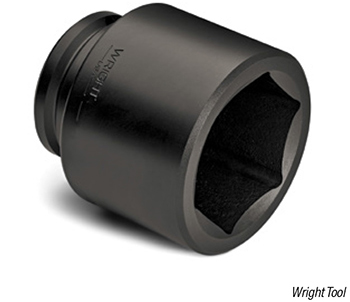 This company’s Wright Drive 2.0 socket design is said to distribute contact stress more effectively than other wrench systems. The Wright Drive 2.0 12-point design has up to 10 times more tool-to-fastener contact area than conventional 12-point wrenches. The design improves fastener torque load while decreasing rounding and distortion of the fastener. The Wright Drive 2.0 six-point design (photo) moves the contact area away from the corners, creating greater strength and more torque. Its circle diameter reduces fastener rounding and allows better grip on undersized fasteners and previously rounded corners. — Wright Tool Co., Barberton, Ohio
This company’s Wright Drive 2.0 socket design is said to distribute contact stress more effectively than other wrench systems. The Wright Drive 2.0 12-point design has up to 10 times more tool-to-fastener contact area than conventional 12-point wrenches. The design improves fastener torque load while decreasing rounding and distortion of the fastener. The Wright Drive 2.0 six-point design (photo) moves the contact area away from the corners, creating greater strength and more torque. Its circle diameter reduces fastener rounding and allows better grip on undersized fasteners and previously rounded corners. — Wright Tool Co., Barberton, Ohio
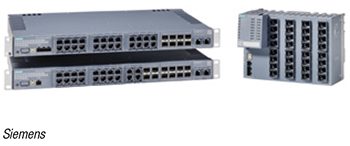 The Scalance XC-/XR-300 (photo) series of Industrial Ethernet switches has been upgraded with a higher port density, which allows many devices to be connected within large network infrastructures. Thanks to their high-bandwidth ports (up to 10 Gbit/s), the new models also enable various OT network applications for data, voice, video and Profinet. With the Industrial Ethernet switches, OT networks are easily connected to IT and thus enable more flexible production. The new switches thus replace the portfolio of the current Scalance X-300 series and carry the model designation Scalance XC-/XCM-300 in the compact version and Scalance XR-/XRM-300 in the 19-in. version. The new Scalance devices were first presented at the Smart Production Solutions (SPS) fair in Nuremberg, Germany in November. — Siemens AG, Munich, Germany
The Scalance XC-/XR-300 (photo) series of Industrial Ethernet switches has been upgraded with a higher port density, which allows many devices to be connected within large network infrastructures. Thanks to their high-bandwidth ports (up to 10 Gbit/s), the new models also enable various OT network applications for data, voice, video and Profinet. With the Industrial Ethernet switches, OT networks are easily connected to IT and thus enable more flexible production. The new switches thus replace the portfolio of the current Scalance X-300 series and carry the model designation Scalance XC-/XCM-300 in the compact version and Scalance XR-/XRM-300 in the 19-in. version. The new Scalance devices were first presented at the Smart Production Solutions (SPS) fair in Nuremberg, Germany in November. — Siemens AG, Munich, Germany
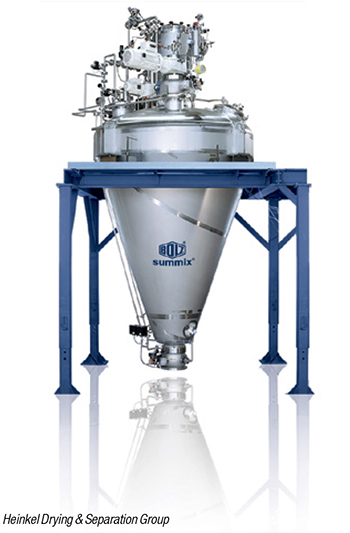 The Bolz conical vacuum mixer-dryer (photo) has been specifically engineered to meet the strictest requirements for vacuum processes by combining multiple processing steps into a single fully enclosed processing system that delivers safer operations by utilizing fixed permanent connections for all aspects of the process. The unit’s applications include drying, de-aeration, crystallization, homogenization, heating, cooling and injection of liquids and gases. The Bolz technology includes orbiting-arm or central shaft agitator designs, a heated agitator to reduce drying times and full clean-in-place (CIP) systems. The low-energy units feature three-dimensional mixing, as well as variable volume filling down to 20% of the unit’s total volume. Sizes range from 1- to 5,000-L working volumes. — Heinkel Drying & Separation Group, Swedesboro, N.J.
The Bolz conical vacuum mixer-dryer (photo) has been specifically engineered to meet the strictest requirements for vacuum processes by combining multiple processing steps into a single fully enclosed processing system that delivers safer operations by utilizing fixed permanent connections for all aspects of the process. The unit’s applications include drying, de-aeration, crystallization, homogenization, heating, cooling and injection of liquids and gases. The Bolz technology includes orbiting-arm or central shaft agitator designs, a heated agitator to reduce drying times and full clean-in-place (CIP) systems. The low-energy units feature three-dimensional mixing, as well as variable volume filling down to 20% of the unit’s total volume. Sizes range from 1- to 5,000-L working volumes. — Heinkel Drying & Separation Group, Swedesboro, N.J.
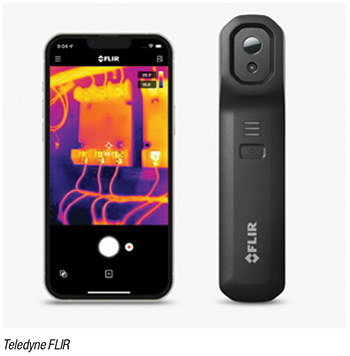 FLIR One Edge Pro (photo) is said to be the first truly wireless thermal-visible camera for mobile devices. Unlike previous models, the reimagined FLIR One Edge Pro doesn’t need to be physically connected to its companion mobile device, nor does it have separate models for specific operating systems, providing maximum flexibility for thermal inspections. The IP54-rated FLIR One Edge Pro has a spring-loaded clip designed to allow operators to attach the camera to many types of mobile phones and tablets. Thanks to the combined Bluetooth and Wi-Fi connection, users can operate the Edge Pro up to 30 m away from their mobile device, providing the flexibility to effectively inspect hard-to-reach places or those scenarios requiring greater standoff distances to maintain operator safety. The device features a 160×120-resolution thermal-imaging camera paired with a visible camera. The MSX image-enhancement feature overlays the edge detail of the visible camera onto the thermal image without sacrificing any thermal data within the image. — Teledyne FLIR LLC, a Teledyne Technologies company, Wilsonville, Ore.
FLIR One Edge Pro (photo) is said to be the first truly wireless thermal-visible camera for mobile devices. Unlike previous models, the reimagined FLIR One Edge Pro doesn’t need to be physically connected to its companion mobile device, nor does it have separate models for specific operating systems, providing maximum flexibility for thermal inspections. The IP54-rated FLIR One Edge Pro has a spring-loaded clip designed to allow operators to attach the camera to many types of mobile phones and tablets. Thanks to the combined Bluetooth and Wi-Fi connection, users can operate the Edge Pro up to 30 m away from their mobile device, providing the flexibility to effectively inspect hard-to-reach places or those scenarios requiring greater standoff distances to maintain operator safety. The device features a 160×120-resolution thermal-imaging camera paired with a visible camera. The MSX image-enhancement feature overlays the edge detail of the visible camera onto the thermal image without sacrificing any thermal data within the image. — Teledyne FLIR LLC, a Teledyne Technologies company, Wilsonville, Ore.